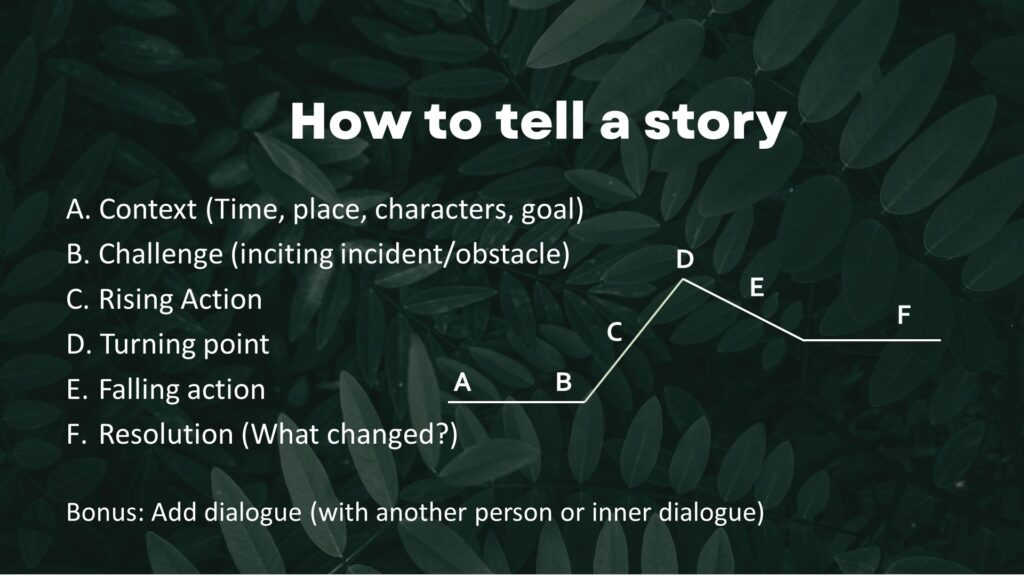Why Tell Stories
The answer lies in the inherent memorability of stories. Cognitive psychologist Jerome Bruner suggests we are 22 times more likely to remember a fact when it has been wrapped in a story. Stories transcend the abstract, connecting directly with our emotions, making them not just memorable but also impactful. In the realm of presentations, where the goal is to leave a lasting impression, stories ensure that the core message is not just heard but remembered.
What Stories to Tell
Relevance is key. A story unrelated to the core message can distract and disengage. Personal anecdotes, success stories, and cautionary tales, when aligned with the presentation’s theme, can significantly enhance relatability and retention. For instance, sharing a success story about overcoming budgeting challenges or the magic of compound interest can illuminate abstract financial concepts in a relatable manner.
How to Tell a Story

Let’s dive into the anatomy of a compelling story, especially when we’re weaving it into presentations or any narrative, really. It’s like setting up dominoes in just the right way to create that perfect cascade. Here’s how it goes:
- (A) Context: This is where you lay down the groundwork. You’re setting the scene, introducing the who, what, where, and when. It’s like inviting your audience into a new world, giving them a glimpse of the landscape.
- (B) Challenge: Every story needs its dragon to slay. This is the problem or obstacle that arises, creating tension and intrigue. It’s what hooks your listeners, drawing them deeper into the narrative.
- (C) Rising Action: Here, the stakes get higher. We’re adding complications, building up the suspense. It’s the part where the audience starts leaning in, completely engrossed, wondering how it’s all going to unfold.
- (D) Turning Point: The climax, the moment of truth. This is where everything changes, where the story pivots in a new direction. It’s the peak of your narrative mountain, and from here, everything starts to fall into place.
- (E) Falling Action: After the climax, we’re on the journey back down. It’s where the consequences of the turning point begin to play out, leading us towards closure. The tension starts to ease, but the interest remains as everything moves towards resolution.
- (F) Resolution: The grand finale, where all the loose ends are tied up. It’s the conclusion where the outcome is revealed, leaving your audience satisfied, reflective, or inspired.
And if we sprinkle in a bit of dialogue, either between characters or as inner thoughts, we’re not just telling a story; we’re bringing it to life, making it resonate on a deeply personal level.
The next time you share a piece of your world, think about these stages in your story flow. They’re your map to crafting stories that not only captivate but also connect, leaving a lasting impression on the heart and mind.
Example Story (with stages indicated)
(A: Context) When speaking at an event, you never, ever want to go past your audience’s lunchtime. You do not want to be the thing that stands in the way of their lunch. Several years ago, I was the speaker scheduled before lunch, right after the keynote speaker, a well-known local TV personality. If I mentioned his name, those of you who live in Minnesota would know who I’m talking about. I was supposed to speak from 11:00 to noon.
(B: Challenge) At 11:00, he was still going strong. “No problem,” I thought. “Easy to adjust.” But by 11:05, with no sign of stopping, I started to get nervous.
(C: Rising Action) By 11:10, I was wondering, “What am I going to cut? I have PowerPoint slides. How am I going to work this?”
(D: Turning Point) Finally, at 11:20, he finishes, and they introduce me.
(E: Falling Action) So, I simply decided not to talk about my last point . . .
(F: Resolution) . . . and was able to finish one minute before noon. It was successful, and I was not in the way of their lunch.
Conclusion
Storytelling is not just an art; it’s a strategic tool in presentations that, when used wisely, can make your message unforgettable. By choosing relevant stories, structuring them effectively, and delivering them at the right time, you can transform your presentations from mundane to memorable. The next time you’re given the stage, remember this: your story has the power to change the room. But more importantly, it has the power to change the world, one heart, one mind at a time. So, what’s your story?
